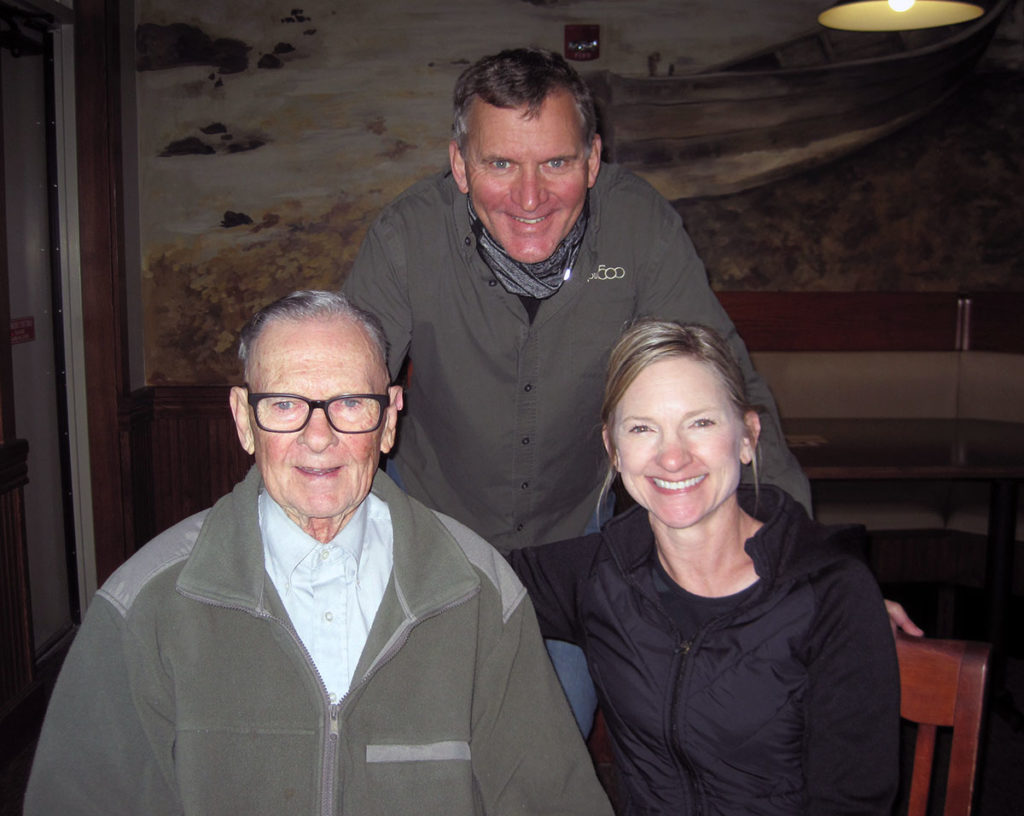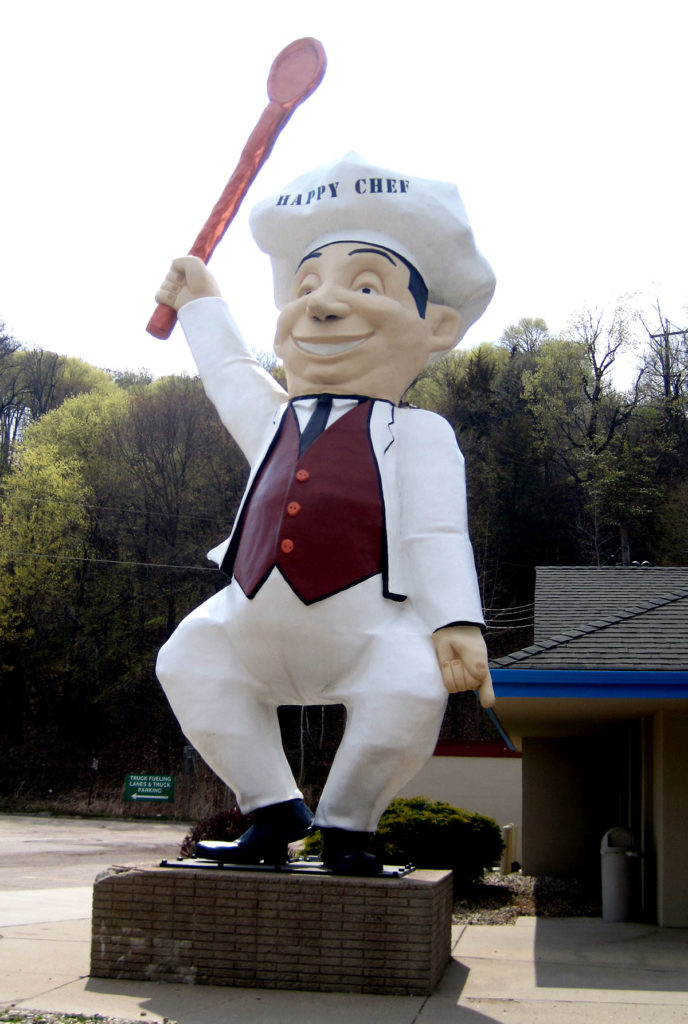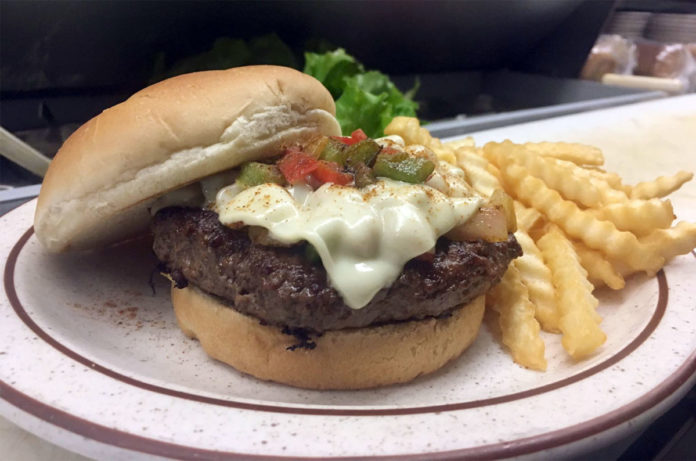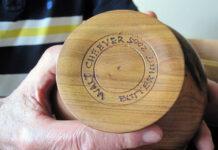Children pushed the button to hear the 36-foot-tall Happy Chef figure speak, travelers confidently stopped at a restaurant with a familiar logo, friends gathered for a chat and a legendary caramel roll, and local business owners perused their stack of daily reports over seemingly endless cups of coffee.
Over the past half century, countless people enjoyed eating at one of 60 Happy Chef restaurants in seven states—Kansas, Nebraska, South Dakota, North Dakota, Iowa, Wisconsin and, of course, Minnesota.
Today, only the original Happy Chef on Hwy. 169 in Mankato remains. Its owner, Adrian Swales, bought the restaurant in 2017. Swales, a former Happy Chef employee, had the Chef’s voice restored three years ago after it stopped communicating with hopeful customers. Children may miss pushing the button, but as they walk toward the motion-sensitive Chef, they are surprised by his cheery greeting. Nature murals painted by local artist Lisa Bierer grace the indoor walls, and the original Happy Chef neon sign is on display inside the building.
The Happy Chef story begins with Tom Frederick, Sr., and his brothers Bob and Sal. (A fourth brother, Bill, was a teacher in Winona and later joined the enterprise.) At age 85, Tom Sr. claims to be retired, but he still goes to the Happy Chef office in Mankato regularly. He checks in with Diane Ziegler, the administrative assistant for Happy Chef Systems and for Minn Inc., the holding company. His son, Tom Jr., owns Pub 500.

A strong work ethic
The work ethic is strong in the Frederick family, beginning with Tom Sr.’s childhood on a farm near Madison Lake.
While a student at Loyola High School in Mankato (to which he rode a bicycle from the farm when weather permitted), Tom worked for Earl Madsen, who owned the supermarket Madsen’s, where Cub West now is located. Thus began Tom’s business education. He explained, “Earl Madsen was my mentor. I worked for Earl for three years and asked a lot of questions. He priced peas at three cans for a dollar rather then 35 cents apiece, and he sold more cans of peas. I learned that if you’re going to be in any kind of business, you have to have all kinds of ways to make money.”
Earl Madsen was my mentor. I worked for Earl for three years and asked a lot of questions.Tom Frederick Sr.
After graduating from high school, Tom took classes by mail from both the University of Minnesota and the University of Wisconsin. He was drafted into the U.S. Army in 1955, and after completing basic training, was assigned to track down soldiers who were absent without leave. This gave him the opportunity to develop ways of finding information, a helpful skill for his future in the restaurant business.

After returning from military service, Tom took a job as a traveling insurance investigator, putting his military experience to use. It also gave him the opportunity to eat lunch in many Minnesota and Iowa communities. That experience may have led to his eventual development of a restaurant chain, but when asked why he chose that enterprise, he said, “I’ve wondered that myself, probably 100 times. Why go into the restaurant business?” Nevertheless, he and his brothers did just that.
I’ve wondered that myself, probably 100 times. Why go into the restaurant business?Tom Frederick Sr.
As the chain of Happy Chef restaurants grew, customers enjoyed menus they found familiar, what might be called “down-home comfort food.” Tom explained, “You can’t button-hole yourself in a smaller town, and we went after the smaller towns.”
Who’s the happy chef today?
The first Frederick-owned restaurant was the Hidden Inn. It was located near the present site of the Law Enforcement Center on South Front Street. Sal Frederick first owned the Hidden Inn and then sold it to his brother Tom in the mid-1950s. Other Frederick-owned restaurants included the Corner Cafe, Brett’s Grill in the upscale Brett’s department store (later part of the downtown Mankato Mall) and a restaurant in the Newman Center (is now the location of the Blue Earth County Historical Society).
Tom, Bob and Sal took turns cooking in the restaurants, which led regular customers to ask, “Who’s the happy chef today?” When the Frederick brothers opened their first family-style restaurant in 1963—on U.S. Hwy. 169 in Mankato, a new road at that time—they chose that catchy question for the restaurant’s name. The figure of the welcoming Happy Chef was the brain child of Bob Muellerleile of M&M Signs.

One of the major assets at the Happy Chef was the chef, “Slim” Wandersee, who became somewhat of a family legend. Tom’s daughter, Jill Frederick Keach, said, “I remember Slim—tall and thin. I heard stories about him when I was a kid—that he had the best recipes for cinnamon rolls and chili.”
Wandersee cooked up recipes he’d learned from his grandmother to produce not only mouth-watering cinnamon rolls and chili, but also delicious caramel rolls and vegetable beef soup. The cook in every Happy Chef restaurant throughout the Midwest received the recipes to use in-house—recipes that have remained favorites for decades.
Wandersee also was in charge of the buffets for which Happy Chef restaurants were well known by the drivers of tour buses. The buffets also served as gathering places for extended families celebrating an anniversary or a birthday.
“I just kept building”
How did this family business grow to include 60-plus restaurants? Tom Sr. said, “I just kept building.” At one time, the family business included not only the Happy Chefs, but also five 1950s-style Ruttles restaurants, two in Mankato, one each in St. Peter and Worthington, and one in Ames, Iowa. Tom Frederick, Jr., began Ruttles—a gourmet hamburger and malt shop–in 1985 as a senior class project in college.
The Frederick family also owned Stoney’s Fine Dining with Ray Schwegman after he retired from Mankato’s legendary Holiday House. Tom Sr. bought out his brothers in 1984 but began to downsize because Minnesota politics in regard to businesses had become troubling to him. He said, “A lot of family restaurants like ours filed bankruptcy. That wasn’t my choice.” Instead, he sold restaurants and carried the buyers’ loans.



